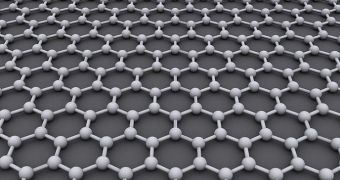The same group of physicists that first obtained the carbon compound graphene nearly 6 years ago announces the development of a new derivative of the material. Called fluorographene, the compound does not conduct electricity at all.
Graphene is known for many of its peculiar physical and chemical properties, and one of them is the ability to conduct electrical current just as effectively as copper can.
But the new derivative, which required some tinkering to create, does not conduct electrons, in essence acting like the exact opposite of its peer. The achievement was made by the same two researchers who won the 2010 Nobel Prize in Physics for obtaining graphene.
This carbon compound features a hexagonal, honeycomb-like structure, which is made up of single carbon atoms affixed to each other. The material is very strong, and has since its discovery been touted as the next big thing for the electronics industry.
Another important aspect of graphene is that it can conduct heat remarkably well, which again opens up a host of prospective applications, PhysOrg reports.
But the new compound University of Manchester physicists Kostya Novoselov and Andre Geim developed is even stronger and more stable than its 2D predecessor.
Fluorographene cannot conduct electricity at well, on account of the fact that each individual carbon atom in the graphene matrix gets a fluorine atom attached to it.
This destroys the electron cloud on graphene, preventing the movement of electrons, and therefore the flow of electricity. Details of the study appear in the latest issue of the top science journal Small.
Fluorographene is “the thinnest possible insulator, made by attaching fluorine atoms to each of the carbon atoms in graphene,” says University of Manchester postgraduate researcher Rahul Raveendran-Nair, who was a part of the investigation.
“It is the first stoichiometric chemical derivative of graphene and it is a wide-gap semiconductor. Fluorographene is a mechanically strong and chemically and thermally stable compound,” he adds.
“Properties of this new material are very similar to Teflon and we call this material 2D Teflon,” the expert adds, saying that the development process associated with obtaining this material was very complex.
“Fluorine is a highly reactive element, and it reacts with almost everything,” Nair explains. “So the major challenge was to fully fluorinate graphene without damaging the graphene and its supporting substrates.” This was successfully achieved by the team and its international collaborators.

 14 DAY TRIAL //
14 DAY TRIAL //